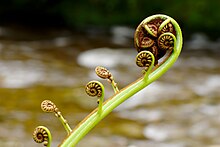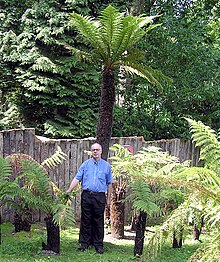Cyatheales
| Tree fern (Cyatheales) Temporal range:
| |
|---|---|

| |
| Dicksonia antarctica | |
| Scientific classification | |
| Kingdom: | Plantae |
| Clade: | Tracheophytes |
| Division: | Polypodiophyta |
| Class: | Polypodiopsida |
| Subclass: | Polypodiidae |
| Order: | Cyatheales A.B.Frank |
| Families | |
Note: These families are alternatively treated as subfamilies of the single family Cyatheaceae [1] | |
The order Cyatheales, which includes most
Some species have scales on the stems and leaves, while others have hairs. However, most plants in the Cyatheales are tree ferns and have trunk-like stems up to 10 metres (33 ft) tall. It is unclear how many times the tree form has evolved and been lost in the order.[3]
Description
While the Cyatheales have been shown to be
Like all ferns, tree ferns reproduce by means of spores developed in sporangia on the undersides of the fronds.

The fronds of tree ferns are usually very large and multiple-
Unlike flowering plants, tree ferns do not form new woody tissue in their trunk as they grow. Rather, the trunk is supported by a fibrous mass of roots that expands as the tree fern grows.
Some genera — for example

The number of tree fern species is likely to be around a thousand. Although new species are discovered in New Guinea with each botanical survey, many species throughout its range have become extinct in the last century as forest habitats have come under pressure from human activities.

Taxonomy
In the molecular phylogenetic classification of Smith et al. in 2006, the Cyatheales were placed in the
Historically, the

| Koral 2006, Koral 2007 & Lehtonen 2011[2][9][10] | Nitta et al. 2022[11] and Fern Tree of life[12] | ||||||||||||||||||||||||||||||||||||||||||||||||||||||||||||||||||||||||||||||||||||
|---|---|---|---|---|---|---|---|---|---|---|---|---|---|---|---|---|---|---|---|---|---|---|---|---|---|---|---|---|---|---|---|---|---|---|---|---|---|---|---|---|---|---|---|---|---|---|---|---|---|---|---|---|---|---|---|---|---|---|---|---|---|---|---|---|---|---|---|---|---|---|---|---|---|---|---|---|---|---|---|---|---|---|---|---|---|
|
|
Incertae sedis fossil genera
- Alienopteris – Cerro Negro Formation, Antarctica, Early Cretaceous (Aptian) (stem)
- Yavanna– Cerro Negro Formation, Antarctica, Early Cretaceous (Aptian) (stem)
- Natalipteris – Mzinene Formation?, South Africa, Cretaceous (Albian-Turonian) (stem)
- Kwazulupteris – Mzinene Formation?, South Africa, Cretaceous (Albian-Turonian) (stem)
- Rafaherbstia – Cerro Negro Formation, Antarctica, Early Cretaceous (Aptian) (stem)
Distribution and habitat
Tree ferns are found growing in
While many ferns are able to achieve a widespread distribution because of their spore reproduction, tree fern species tend to be very local. This makes their species much more susceptible to the effects of local deforestation. Why species are not more widespread is unknown, especially considering they have sufficient height to have a greater chance of getting spores into the wind stream.[citation needed]
Conservation
Where

References
- ^ PMID 24532607.
- ^ PMID 21636456.
- ^ Judd, W.S., C.S. Campbell, E.A. Kellogg, P.F. Stevens, and M.J. Donoghue (Eds.) 2008. Plant Systematics: A Phylogenetic Approach, Third Edition. Sinauer Associates, Sunderland, Massachusetts, USA.
- ISBN 978-0-521-69689-0.
- JSTOR 25065646. Archived from the original(PDF) on 2021-12-09. Retrieved 2016-12-22.
- ^ .
- .
- S2CID 39980610.[permanent dead link]
- PMID 16481203.
- PMID 22022365.
- PMID 36092417.
- ^ "Tree viewer: interactive visualization of FTOL". FTOL v1.5.0 [GenBank release 256]. 2023. Retrieved 17 August 2023.
- ISBN 978-1-55963-051-1.
- Pryer, K.M.; Smith, A.R.; Skog, J.E. (1995). "Phylogenetic relationships of extant ferns based on evidence from morphology and rbcL sequences". American Fern Journal. 85 (4): 205–282. JSTOR 1547810.
- C.Michael Hogan. 2010. Fern. Encyclopedia of Earth. National council for Science and the Environment. Washington, DC
- Large, M.F. and J.E. Braggins Tree Ferns. Timber Press (2004).
- Smith, A.R., K.M. Pryer, E. Schuettpelz, P. Korall, H. Schneider & P.G. Wolf 2006. "A classification for extant ferns" (PDF). Archived from the original (PDF) on 2008-02-26. (420 KiB) Taxonomy 55(3): 705-731.
External links
- Community: Care and propagation of Treeferns (German/English)
- Fern Files: Tree Ferns
